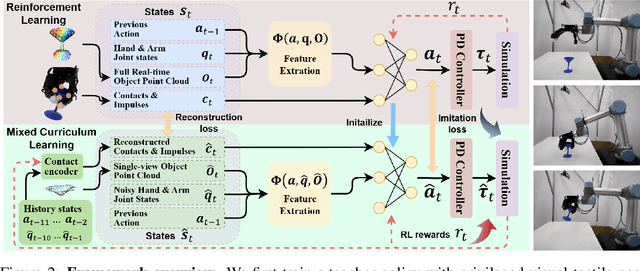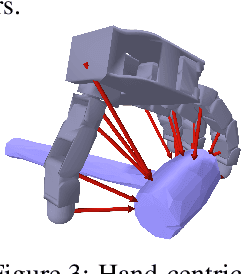Jie Song
MagicHOI: Leveraging 3D Priors for Accurate Hand-object Reconstruction from Short Monocular Video Clips
Aug 07, 2025Abstract:Most RGB-based hand-object reconstruction methods rely on object templates, while template-free methods typically assume full object visibility. This assumption often breaks in real-world settings, where fixed camera viewpoints and static grips leave parts of the object unobserved, resulting in implausible reconstructions. To overcome this, we present MagicHOI, a method for reconstructing hands and objects from short monocular interaction videos, even under limited viewpoint variation. Our key insight is that, despite the scarcity of paired 3D hand-object data, large-scale novel view synthesis diffusion models offer rich object supervision. This supervision serves as a prior to regularize unseen object regions during hand interactions. Leveraging this insight, we integrate a novel view synthesis model into our hand-object reconstruction framework. We further align hand to object by incorporating visible contact constraints. Our results demonstrate that MagicHOI significantly outperforms existing state-of-the-art hand-object reconstruction methods. We also show that novel view synthesis diffusion priors effectively regularize unseen object regions, enhancing 3D hand-object reconstruction.
MoGA: 3D Generative Avatar Prior for Monocular Gaussian Avatar Reconstruction
Jul 31, 2025Abstract:We present MoGA, a novel method to reconstruct high-fidelity 3D Gaussian avatars from a single-view image. The main challenge lies in inferring unseen appearance and geometric details while ensuring 3D consistency and realism. Most previous methods rely on 2D diffusion models to synthesize unseen views; however, these generated views are sparse and inconsistent, resulting in unrealistic 3D artifacts and blurred appearance. To address these limitations, we leverage a generative avatar model, that can generate diverse 3D avatars by sampling deformed Gaussians from a learned prior distribution. Due to the limited amount of 3D training data such a 3D model alone cannot capture all image details of unseen identities. Consequently, we integrate it as a prior, ensuring 3D consistency by projecting input images into its latent space and enforcing additional 3D appearance and geometric constraints. Our novel approach formulates Gaussian avatar creation as a model inversion process by fitting the generative avatar to synthetic views from 2D diffusion models. The generative avatar provides a meaningful initialization for model fitting, enforces 3D regularization, and helps in refining pose estimation. Experiments show that our method surpasses state-of-the-art techniques and generalizes well to real-world scenarios. Our Gaussian avatars are also inherently animatable
Dataset Ownership Verification for Pre-trained Masked Models
Jul 16, 2025Abstract:High-quality open-source datasets have emerged as a pivotal catalyst driving the swift advancement of deep learning, while facing the looming threat of potential exploitation. Protecting these datasets is of paramount importance for the interests of their owners. The verification of dataset ownership has evolved into a crucial approach in this domain; however, existing verification techniques are predominantly tailored to supervised models and contrastive pre-trained models, rendering them ill-suited for direct application to the increasingly prevalent masked models. In this work, we introduce the inaugural methodology addressing this critical, yet unresolved challenge, termed Dataset Ownership Verification for Masked Modeling (DOV4MM). The central objective is to ascertain whether a suspicious black-box model has been pre-trained on a particular unlabeled dataset, thereby assisting dataset owners in safeguarding their rights. DOV4MM is grounded in our empirical observation that when a model is pre-trained on the target dataset, the difficulty of reconstructing masked information within the embedding space exhibits a marked contrast to models not pre-trained on that dataset. We validated the efficacy of DOV4MM through ten masked image models on ImageNet-1K and four masked language models on WikiText-103. The results demonstrate that DOV4MM rejects the null hypothesis, with a $p$-value considerably below 0.05, surpassing all prior approaches. Code is available at https://github.com/xieyc99/DOV4MM.
Diffusion Model Quantization: A Review
May 08, 2025Abstract:Recent success of large text-to-image models has empirically underscored the exceptional performance of diffusion models in generative tasks. To facilitate their efficient deployment on resource-constrained edge devices, model quantization has emerged as a pivotal technique for both compression and acceleration. This survey offers a thorough review of the latest advancements in diffusion model quantization, encapsulating and analyzing the current state of the art in this rapidly advancing domain. First, we provide an overview of the key challenges encountered in the quantization of diffusion models, including those based on U-Net architectures and Diffusion Transformers (DiT). We then present a comprehensive taxonomy of prevalent quantization techniques, engaging in an in-depth discussion of their underlying principles. Subsequently, we perform a meticulous analysis of representative diffusion model quantization schemes from both qualitative and quantitative perspectives. From a quantitative standpoint, we rigorously benchmark a variety of methods using widely recognized datasets, delivering an extensive evaluation of the most recent and impactful research in the field. From a qualitative standpoint, we categorize and synthesize the effects of quantization errors, elucidating these impacts through both visual analysis and trajectory examination. In conclusion, we outline prospective avenues for future research, proposing novel directions for the quantization of generative models in practical applications. The list of related papers, corresponding codes, pre-trained models and comparison results are publicly available at the survey project homepage https://github.com/TaylorJocelyn/Diffusion-Model-Quantization.
NTIRE 2025 Challenge on UGC Video Enhancement: Methods and Results
May 05, 2025Abstract:This paper presents an overview of the NTIRE 2025 Challenge on UGC Video Enhancement. The challenge constructed a set of 150 user-generated content videos without reference ground truth, which suffer from real-world degradations such as noise, blur, faded colors, compression artifacts, etc. The goal of the participants was to develop an algorithm capable of improving the visual quality of such videos. Given the widespread use of UGC on short-form video platforms, this task holds substantial practical importance. The evaluation was based on subjective quality assessment in crowdsourcing, obtaining votes from over 8000 assessors. The challenge attracted more than 25 teams submitting solutions, 7 of which passed the final phase with source code verification. The outcomes may provide insights into the state-of-the-art in UGC video enhancement and highlight emerging trends and effective strategies in this evolving research area. All data, including the processed videos and subjective comparison votes and scores, is made publicly available at https://github.com/msu-video-group/NTIRE25_UGC_Video_Enhancement.
Quantizing Diffusion Models from a Sampling-Aware Perspective
May 04, 2025Abstract:Diffusion models have recently emerged as the dominant approach in visual generation tasks. However, the lengthy denoising chains and the computationally intensive noise estimation networks hinder their applicability in low-latency and resource-limited environments. Previous research has endeavored to address these limitations in a decoupled manner, utilizing either advanced samplers or efficient model quantization techniques. In this study, we uncover that quantization-induced noise disrupts directional estimation at each sampling step, further distorting the precise directional estimations of higher-order samplers when solving the sampling equations through discretized numerical methods, thereby altering the optimal sampling trajectory. To attain dual acceleration with high fidelity, we propose a sampling-aware quantization strategy, wherein a Mixed-Order Trajectory Alignment technique is devised to impose a more stringent constraint on the error bounds at each sampling step, facilitating a more linear probability flow. Extensive experiments on sparse-step fast sampling across multiple datasets demonstrate that our approach preserves the rapid convergence characteristics of high-speed samplers while maintaining superior generation quality. Code will be made publicly available soon.
ODHSR: Online Dense 3D Reconstruction of Humans and Scenes from Monocular Videos
Apr 18, 2025Abstract:Creating a photorealistic scene and human reconstruction from a single monocular in-the-wild video figures prominently in the perception of a human-centric 3D world. Recent neural rendering advances have enabled holistic human-scene reconstruction but require pre-calibrated camera and human poses, and days of training time. In this work, we introduce a novel unified framework that simultaneously performs camera tracking, human pose estimation and human-scene reconstruction in an online fashion. 3D Gaussian Splatting is utilized to learn Gaussian primitives for humans and scenes efficiently, and reconstruction-based camera tracking and human pose estimation modules are designed to enable holistic understanding and effective disentanglement of pose and appearance. Specifically, we design a human deformation module to reconstruct the details and enhance generalizability to out-of-distribution poses faithfully. Aiming to learn the spatial correlation between human and scene accurately, we introduce occlusion-aware human silhouette rendering and monocular geometric priors, which further improve reconstruction quality. Experiments on the EMDB and NeuMan datasets demonstrate superior or on-par performance with existing methods in camera tracking, human pose estimation, novel view synthesis and runtime. Our project page is at https://eth-ait.github.io/ODHSR.
RobustDexGrasp: Robust Dexterous Grasping of General Objects from Single-view Perception
Apr 07, 2025



Abstract:Robust grasping of various objects from single-view perception is fundamental for dexterous robots. Previous works often rely on fully observable objects, expert demonstrations, or static grasping poses, which restrict their generalization ability and adaptability to external disturbances. In this paper, we present a reinforcement-learning-based framework that enables zero-shot dynamic dexterous grasping of a wide range of unseen objects from single-view perception, while performing adaptive motions to external disturbances. We utilize a hand-centric object representation for shape feature extraction that emphasizes interaction-relevant local shapes, enhancing robustness to shape variance and uncertainty. To enable effective hand adaptation to disturbances with limited observations, we propose a mixed curriculum learning strategy, which first utilizes imitation learning to distill a policy trained with privileged real-time visual-tactile feedback, and gradually transfers to reinforcement learning to learn adaptive motions under disturbances caused by observation noises and dynamic randomization. Our experiments demonstrate strong generalization in grasping unseen objects with random poses, achieving success rates of 97.0% across 247,786 simulated objects and 94.6% across 512 real objects. We also demonstrate the robustness of our method to various disturbances, including unobserved object movement and external forces, through both quantitative and qualitative evaluations. Project Page: https://zdchan.github.io/Robust_DexGrasp/
3D Gaussian Inverse Rendering with Approximated Global Illumination
Apr 02, 2025Abstract:3D Gaussian Splatting shows great potential in reconstructing photo-realistic 3D scenes. However, these methods typically bake illumination into their representations, limiting their use for physically-based rendering and scene editing. Although recent inverse rendering approaches aim to decompose scenes into material and lighting components, they often rely on simplifying assumptions that fail when editing. We present a novel approach that enables efficient global illumination for 3D Gaussians Splatting through screen-space ray tracing. Our key insight is that a substantial amount of indirect light can be traced back to surfaces visible within the current view frustum. Leveraging this observation, we augment the direct shading computed by 3D Gaussians with Monte-Carlo screen-space ray-tracing to capture one-bounce indirect illumination. In this way, our method enables realistic global illumination without sacrificing the computational efficiency and editability benefits of 3D Gaussians. Through experiments, we show that the screen-space approximation we utilize allows for indirect illumination and supports real-time rendering and editing. Code, data, and models will be made available at our project page: https://wuzirui.github.io/gs-ssr.
Boosting MLLM Reasoning with Text-Debiased Hint-GRPO
Mar 31, 2025Abstract:MLLM reasoning has drawn widespread research for its excellent problem-solving capability. Current reasoning methods fall into two types: PRM, which supervises the intermediate reasoning steps, and ORM, which supervises the final results. Recently, DeepSeek-R1 has challenged the traditional view that PRM outperforms ORM, which demonstrates strong generalization performance using an ORM method (i.e., GRPO). However, current MLLM's GRPO algorithms still struggle to handle challenging and complex multimodal reasoning tasks (e.g., mathematical reasoning). In this work, we reveal two problems that impede the performance of GRPO on the MLLM: Low data utilization and Text-bias. Low data utilization refers to that GRPO cannot acquire positive rewards to update the MLLM on difficult samples, and text-bias is a phenomenon that the MLLM bypasses image condition and solely relies on text condition for generation after GRPO training. To tackle these problems, this work proposes Hint-GRPO that improves data utilization by adaptively providing hints for samples of varying difficulty, and text-bias calibration that mitigates text-bias by calibrating the token prediction logits with image condition in test-time. Experiment results on three base MLLMs across eleven datasets demonstrate that our proposed methods advance the reasoning capability of original MLLM by a large margin, exhibiting superior performance to existing MLLM reasoning methods. Our code is available at https://github.com/hqhQAQ/Hint-GRPO.
 Add to Chrome
Add to Chrome Add to Firefox
Add to Firefox Add to Edge
Add to Edge